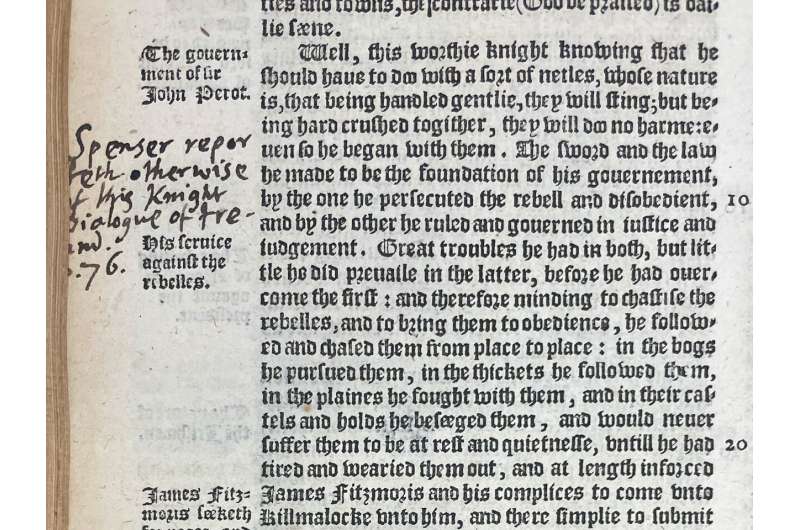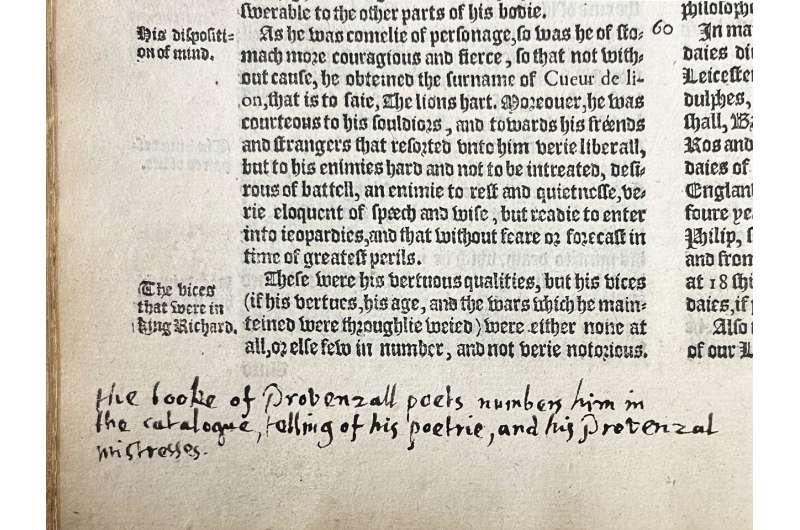This article has been reviewed according to Science X's editorial process and policies. Editors have highlighted the following attributes while ensuring the content's credibility:
fact-checked
trusted source
proofread
John Milton's notes discovered, including a rare example of prudish censorship
![John Milton censors Raphael Holinshed's lewd anecdote about the mother of William the Conqueror, Arlete. Milton crosses the passage out with a diagonal line and adds a note saying: "an unbecom[ing] / tale for a hist[ory] / and as pedlerl[y] / expresst". Credit: By permission of the Phoenix Public Library John Milton's notes discovered, including a rare example of prudish censorship](https://scx1.b-cdn.net/csz/news/800a/2024/john-miltons-notes-dis.jpg)
John Milton's handwritten annotations have been identified in a copy of Raphael Holinshed's Chronicles (1587), a vital source of inspiration for the Paradise Lost poet. The discovery, made in the Burton Barr Central Library in Phoenix, Arizona, makes this one of only three known books to preserve Milton's handwritten reading notes, and one of only nine books to have survived from his library.
The findings, detailed by three researchers in the Times Literary Supplement, include Milton censoring Holinshed by crossing out a lewd anecdote about the mother of William the Conqueror, Arlete.
Spotted while dancing by Robert I of Normandy, and summoned to his bed, Arlete refused to let him lift up her smock and instead tore it herself from top to bottom, explaining that it would be immodest for her 'dependant' garments to be 'mountant' to her sovereign's mouth.
In the margin, Milton dismisses this anecdote as inappropriate and told in the style of a pedlar hawking wares on the streets. In Milton's exact words, it was: "an unbecom[ing] / tale for a hist[ory] / and as pedlerl[y] / expresst."
"The adverb 'pedlerly' was quite rare in writing at the time so we are seeing Milton really stretching language to express his contempt," said co-author Prof. Jason Scott-Warren, from Cambridge University's English Faculty, who was consulted to confirm that the handwriting was Milton's.
"Milton is renowned as an enemy of press censorship," Scott-Warren said, "but here we see he was not immune to prudishness."
Milton crossed through the passage with a single, light diagonal line so the words beneath remain fully legible.
The discovery was made thanks to the Arizona Book History Group, a research forum at the Phoenix Public Library organized by Assistant Prof. Brandi Adams and Prof. Jonathan Hope, both from Arizona State University's Dept. of English. Adams and Hope raised funds for four visiting scholars to study books in the library's Alfred Knight Collection.
In March this year, these researchers included the two other authors of this study: Dr. Aaron Pratt, Curator of Early Books & Manuscripts at University of Texas; and Claire Bourne, an associate professor of English at Penn State. Holinshed's Chronicles, bound in two hefty volumes, was among a number of books that the researchers requested to see.
On 1 March, Dr. Pratt noticed a surprising little "e" in notations added to the book. "I was like, 'God, there's no way in hell this is true, but it kind of looks like this stupid way Milton writes 'e,'" Pratt said.
Intrigued, Pratt kept looking and started seeing scratchy brackets with notations in the margins, brackets that looked very similar to those found in one of the two other known books with Milton's handwriting, Shakespeare's First Folio, which Bourne and Scott-Warren found in 2019 in the Philadelphia Free Library.
Bourne started to compare the annotations in Holinshed's "Chronicles" with those in the Shakespeare Folio. "We're kind of going back and forth, like, is that double 'l' similar? Is that double 's' similar?" Bourne said.

Bourne then texted photos of the handwriting and brackets to Jason Scott-Warren, Director of the Cambridge Center for Material Texts and a Fellow of Gonville and Caius College.
In 2019, Scott-Warren identified Milton as the annotator of a copy of the Shakespeare First Folio in the Free Library of Philadelphia, building on Bourne's research. Academics and media reports called this one of the most important literary discoveries of modern times. Since then, the pair have employed research assistants to look for other surviving books from Milton's library, with no luck.
Bourne wasn't sure how Scott-Warren would respond to the Holinshed notations, describing him as "very conservative" when it comes to reaching such verdicts. But his reply was rapid and enthusiastic: "Wow. Bingo!"
Milton's handwriting
Scott-Warren's assessment involved comparing the handwriting in the Holinshed annotations with Milton's handwriting preserved in two surviving holograph manuscripts: the Commonplace Book (British Library) and the Trinity Manuscript (Trinity College, Cambridge).
Milton's handwriting evolved in the 1630s and the version preserved in the Holinshed matches entries dating from the early 1640s in both manuscripts. The annotations consistently deploy italic e (e)—a feature Milton adopted before his trip to Italy in 1638–39—rather than the epsilon e (ε) used previously. Other features fit with what we know of Milton's neat italic hand, which rarely featured joined letters. Giveaways include hooks and curls on particular letters and a characteristic unevenness in the formation of small 's's.
Milton and Holinshed
Holinshed's massive account of English, Irish and Scottish history from antiquity to the reign of Elizabeth I was a major source for Shakespeare's histories and other plays including "Macbeth." Milton himself repeatedly quoted Holinshed in his Commonplace Book, to support his republican views. The researchers found that over 90% of these references correspond with passages marked in the Knight Collection copy of the second bound volume.
The researchers found around 100 examples in this volume alone. On page 87, a bracket marks a passage recording that Henry II's wife Eleanor was "enraged against hir husband bicause he kept sundrie concubines," which Milton notes in the Commonplace Book: "Concubinatus" ... turn'd both wife & children against our Hen. 2. Holinsh. p. 87."
And in his notes on kings and tyrants, Milton transcribes a number of details that he marked out in Holinshed's account of Richard II's deposition, including one which Milton would later use to justify the execution of Charles I.
In the Trinity Manuscript, Milton borrowed source material from the "Chronicles" to plan a series of proposed historical dramas. Milton used two pages of material from Holinshed's history of Scotland to describe his idea for the first of five "Scotch stories," a violent revenge narrative involving a witch.

Significance
The researchers believe that the discovery opens up new perspectives on his engagement with a major source for his writings, including Of "Reformation "(1641) and "The History of Britain" (1670). He would have been working on both around the time—or shortly after—he was reading the "Chronicles".
Several of Milton's notes cite other books known to have been in his library. These include John Stow's "Annales", another key source of historical information. Milton also marked out Holinshed quoting Giovanni Villani's "Chroniche di Firenze" ("Chronicles of Florence"), a book which Milton included in the curriculum he developed for his nephews in the 1640s.
The notes also emphasize Milton's interest in continental poetry. Under Holinshed's assertion that Richard the Lionheart was "not very notorious," Milton added, "the booke of Provenzall poets numbers him in / the catalogue, telling of his poetrie, and his Provenzal / mistresses." The researchers believe this book refers to Jean de Nostredame's "Les vies des plus célèbres et anciens poètes provençaux" (Lyon, 1575), which discusses Richard's poetry and mistresses.
Scott-Warren said, "This discovery also serves as additional confirmation that the Shakespeare First Folio belonged to Milton. Both books feature the same swooping brackets, and they display closely comparable annotative practices. And they remind us of just how voracious he was as a reader."
Life after Milton
What happened to Milton's books after his death in 1674 remains unclear, but it is widely accepted that they were sold off in batches. The trail of the Holinshed goes cold for well over a century. Around 1800, someone had the volumes rebound. Within a few decades, new endpapers were added, and around 1847, the ecclesiastical historian and collector William Maskell signed the book and began adding his own notes.
By 1942, the volumes had made their way to Beverly Hills, California, where the bookseller Maxwell Hunley sold them to the real estate magnate and philanthropist Alfred Knight. In 1958, Knight bequeathed them to the people of Phoenix, Arizona.
The researchers point out that public libraries like Phoenix's are "are off the beaten path for academics who work with early modern books and manuscripts." This discovery, barely five years after the Shakespeare Folio was found in another US public library, suggests that more of Milton's books may be out there, including in less well-known collections.
More information: Claire M. L. Bourne, Aaron T. Pratt, and Jason Scott-Warren, "The hand of Milton: Identifying the author's annotated copy of Holinshed's Chronicles," Times Literary Supplement (2024)
Provided by University of Cambridge





















